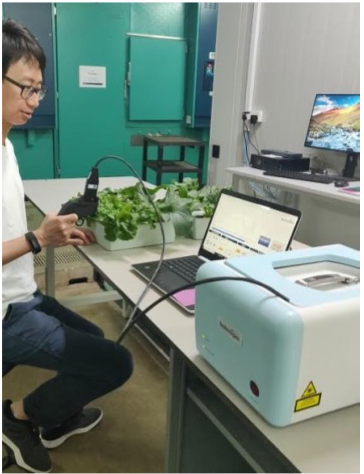Singapore-MIT Alliance for Research and Technology
January 4, 2021

A portable leaf-clip Raman sensor in use at Temasek Life Sciences Laboratory detects nutrient stress in leafy vegetables.
Researchers at the Singapore-MIT Alliance for Research and Technology (SMART) and Temasek Life Sciences Laboratory (TLL) have designed a portable optical sensor that can monitor whether a plant is under stress. The device offers farmers and plant scientists a new tool for early diagnosis and real-time monitoring of plant health in field conditions.
Precision agriculture is an important strategy for tackling growing food insecurity through sustainable farming practices, but it requires new technologies for rapid diagnosis of plant stresses before the onset of visible symptoms and subsequent yield loss. SMART’s new portable Raman leaf-clip sensor is a useful tool in precision agriculture allowing early diagnosis of nitrogen deficiency in plants, which can be linked to premature leaf deterioration and loss of yield.
In a paper titled “Portable Raman leaf-clip sensor for rapid detection of plant stress,” published in the journal Scientific Reports, the scientists explain how they designed, constructed, and tested the leaf clip that allows the optical sensor to probe the leaf chemistry and establish the stress state. The work was developed in the Disruptive and Sustainable Technologies for Agricultural Precision (DiSTAP) Interdisciplinary Research Group (IRG) within SMART, MIT’s research enterprise in Singapore.
“Our findings showed that in vivo measurements using the portable leaf-clip Raman sensor under full-light growth conditions were consistent with measurements obtained with a benchtop Raman spectrometer on leaf sections under laboratory conditions,” says MIT professor of electrical engineering and computer science Rajeev Ram, co-lead author of the paper and principal investigator at DiSTAP. “We demonstrated that early diagnosis of nitrogen deficiency — a critical nutrient, and the most important component of fertilizers — in living plants is possible with the portable sensor.”
While the study mainly looked at measuring nitrogen levels in plants, the device can also be used to detect levels of other plant stress phenotypes such as drought, heat and cold stress, saline stress, and light stress. The wide range of plant stressors that can be detected by these leaf-clip Raman probes and their simplicity and speed makes them ideal for field use by farmers to ensure crop health.
“While we have focused on the early and specific diagnosis of nitrogen deficiency using the leaf-clip sensor, we were able to measure peaks from other metabolites that are also clearly observed in popular vegetables such as kailan, lettuce, choy sum, pak choi, and spinach,” says Chung Hao Huang, co-first author of the paper and a postdoc at TLL.
The team believes their findings can aid farmers to maximize crop yield, while ensuring minimal negative impacts on the environment, including minimizing pollution of aquatic ecosystems by reducing nitrogen runoff and infiltration into the water table.
“The sensor was demonstrated on multiple vegetable varieties and supports the effort to produce nutritious, low-cost vegetables as part of the Singapore 30-by-30 initiative,” says Professor Nam-Hai Chua, co-lead principal investigator at DiSTAP, deputy chair at TLL, and co-lead author of the study. “Extension of this work to a wider variety of crops may contribute globally to improved crop yields, greater climate resiliency, and mitigation of environmental pollution through reduced fertilizer use.”
The portable Raman system was designed in collaboration with local company TechnoSpex. The leaf-clip Raman sensor consists of a 3D printed clip that is built around a fiber-based Raman probe assembly.
Shilpi Gupta, postdoc at DiSTAP, was co-first author of the paper and Gajendra Pratap Singh, scientific director at DiSTAP, also co-authored the article. The research was carried out by SMART and supported by the National Research Foundation (NRF) Singapore under its Campus for Research Excellence And Technological Enterprise (CREATE) program.
The DiSTAP program addresses deep problems in food production in Singapore and the world by developing a suite of impactful and novel analytical, genetic, and biosynthetic technologies. The goal is to fundamentally change how plant biosynthetic pathways are discovered, monitored, engineered and ultimately translated to meet the global demand for food and nutrients.
Scientists from MIT, TLL, Nanyang Technological University, and National University of Singapore are collaboratively developing new tools for the continuous measurement of important plant metabolites and hormones for novel discovery and deeper understanding and control of plant biosynthetic pathways in ways not yet possible, especially in the context of green leafy vegetables; leveraging these new techniques to engineer plants with highly desirable properties for global food security, including high yield density production, drought and pathogen resistance, and biosynthesis of high-value commercial products; developing tools for producing hydrophobic food components in industry-relevant microbes; developing novel microbial and enzymatic technologies to produce volatile organic compounds that can protect and/or promote growth of leafy vegetables; and applying these technologies to improve urban farming.
DiSTAP is led by MIT co-lead principal investigator Professor Michael Strano and Singapore co-lead principal investigator Professor Chua Nam Hai.
SMART was established by MIT and the NRF in 2007. SMART is the first entity in CREATE developed by NRF. SMART serves as an intellectual and innovation hub for research interactions between MIT and Singapore, undertaking cutting-edge research projects in areas of interest to both. SMART currently comprises an Innovation Centre and five IRGs: Antimicrobial Resistance, Critical Analytics for Manufacturing Personalized-Medicine, DiSTAP, Future Urban Mobility, and Low Energy Electronic Systems.